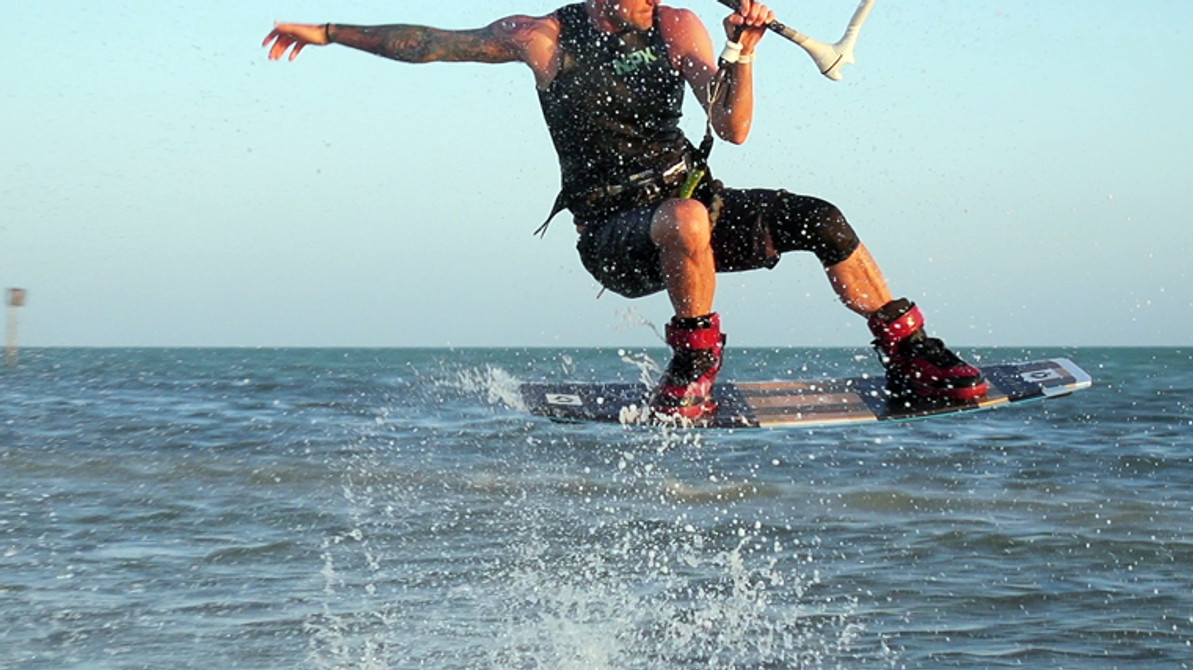Kiteboarding - How to pop unhooked
This blog will eventually be made into a complete beginners' unhooked playlist. Stand by while we film this spring.
This week we're going to break down the most fundamental move in kiteboarding: the pop. In freestyle kiteboarding, all advanced kiteboarding tricks can be broken down into smaller tricks. That means you have to master the basics, and it doesn’t get any more basic than a good pop. Think of this as your foundation whether you want to progress into air tricks, the park or just get more creative with your environment.
Unhooked popping is similar to doing a sent jump, but there are quite a few differences. Once you learn it, you can really get creative on the water. Once you learn the pop you can try frontside or backside 180’s. Add grabs, or progress into your first air tricks.
The only prereqs for this trick are being able to ride upwind, re-launching your kite and understanding the fundamentals of unhooking. Being able to do a sent jump actually helps a lot. They are similar but different. We'll break this trick down into four steps.
As this is a fundamental, I’m going to start with some theory before diving into the drills
Theory
Popping with the kite low or unhooked is different from a sent jump. When you send the kite, you're loading pressure into the lines as you stomp down and pull the bar and the kite rips you off the water. You'll be doing something similar except now the kite is low and fully powered as you load the lines. This means, like cable boarding, you need to use your board speed and edging to load energy into the lines. You can't sheet in and take off. The technique is different.
We're going to cover some drills to teach you the basics of air ticks. The point of these drills are to work your way into it. As you improve your pop, you can start adding half loaded grabs, spins and other variations to your riding. The ultimate goal here is to progress into air tricks with good form.
It's tempting to progress along to the next step quickly, but you will thank yourself later if you take the time to learn properly now and build that muscle memory.
Another recommendation would be to learn each step in both right and left directions. Doing this now will amplify your trick count and make each tack an opportunity for a new trick. This will also help you learn new tricks that align with your strengths. For instance, a front roll for most riders forces you to spin in an "unnatural" direction. If you ride and pop the trick on your unnatural riding direction, it will allow you to spin your preferred direction for the front roll. Additionally, when you get to passing tricks, you may prefer to pass with one arm over the other. Being able to ride in both directions will afford you the freedom to decide which way works best for you and your strengths, rather than re-learning the basics again. The more muscle memory you build on one side, the harder it gets to re-learn it on the other side.
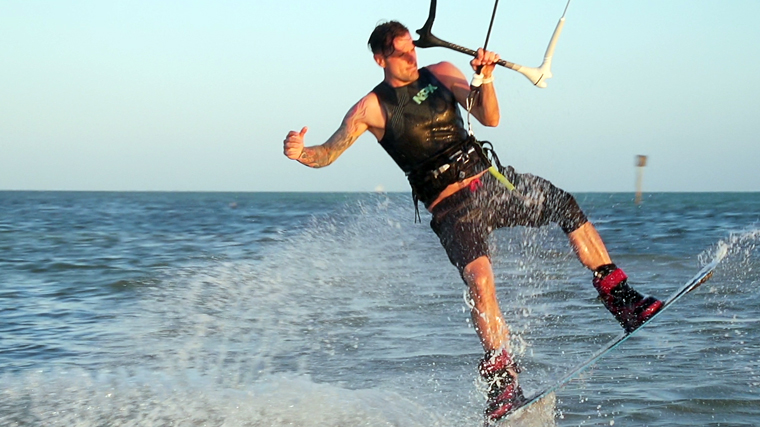
Use chop for extra lift
Drill one - First attempts
The goal here is to get used to getting airborne unhooked. You'll be learning how to ollie. I recommend starting with a piece of chop for extra air. While hooked in, park your kite around 11 or 1. Ride slightly downwind and let off your edge. This will take the tension out of your lines so you can unhook. Split the bar with your index and middle finger. This will keep you from sending the kite too high or low. Find a small piece of chop and ride at it. As you ride up it, keep the bar close. Keep the bar somewhere between your chest and your hips. Maintain a slight bend in your elbow so the bar doesn’t get away from you. As you ride up the chop, stomp down on your back leg. At the same time, bring your front leg up to your chest. As you leave the chop, bring the back leg into your chest right after.
You should feel a transfer of energy from the control bar into your board as you pop off the chop. Remember to keep the bar close to your hips and keep your knees slightly bent. If the kite is pulling away from you, try to pop more downwind. This is a great drill of understanding how to control the power of your kite as well. You want to focus on staying with the bar. As you come down, land flat and downwind. Keep your knees over your shoulders and bend them as necessary to absorb the impact.
This drill should give you a solid foundation with unhooked principles. You will be learning a few things:
- How to control the kite unhooked with one hand
- Body awareness while unhooked
- How to stay with the control bar
- How to land properly for more powered tricks
The whole point of this drill is to build the basic skills needed. It will also be a great way to improve confidence with unhooked riding. Eventually, this will be very useful if you hope to ollie onto kite park features.
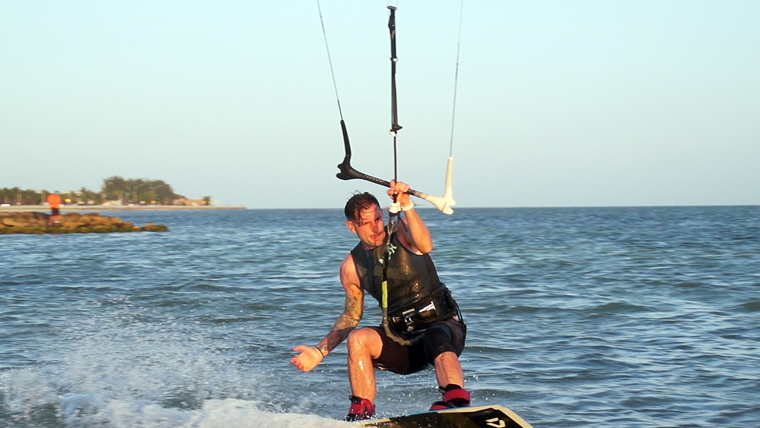
Use a gentle load at first
Drill two - Learning to load the lines
In this step, you're going to learn to load your lines. This is the same as step one except now you're going to lean back to engage your edge a little. The goal is to start loading pressure into the lines before you ollie. Like I mentioned, popping with the kite low or unhooked is different from a sent jump. You're going to learn how to use edging to load tension into your lines. For this step, get into the habit of keeping your hands close to the middle of the bar. This will be more important later on, but it's a good habit to establish now. You can do this with one or two hands on the bar. If you use two hands, you can hold down more power.
Get decent speed, come off your edge for a moment and unhook. Re-engage your edge and lean back slightly. Keep your hips locked upright and roll your shoulders back.
You'll feel a little pressure load up in the lines; now carve away from the kite and stomp down with your back heel. This can be done with or without chop. With the extra power, you will be repeating step one. You might find that you have too much power on this step. If that's the case, the bar might come out of your hand. There are two things you can do here. First, you can try again and load less power into the kite. Second, you can pull the bar harder into your lead hip and go further downwind in the air.
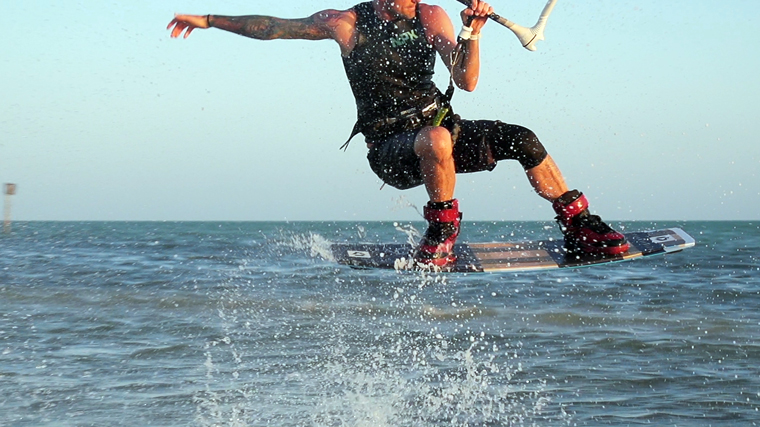
Bend your knees, fly downwind and keep that bar close
This is a great drill to help you understand loading the lines and getting used to controlling your pop. As you leave the water, bring your knees tight into your chest. This step is closer to an ollie on a skateboard or wakeboard. At the apex of your jump, pull the bar towards your front hip. As the same time, point the nose of your board towards the kite. This will set you up for a flat landing. With a slight bend in your knees, land flat, absorb the landing, and ride downwind. Technically you could land on an edge, but you want to get in the habit of landing flat and downwind for more powered tricks. This trick is all about establishing good habits for more advanced tricks.
This drill will help you develop the muscle memory needed to progress into every other unhooked trick. The only factor that changes from trick to trick is how much power you bring and how you release your edge. We'll break those down in individual videos. The faster you go, the harder you edge, and the more you scoop, the higher your body and legs will go. We'll cover the scoop in the next drill. Make sure you spend enough time on this drill in particular. Establishing good form on the landing is important for the next drill.
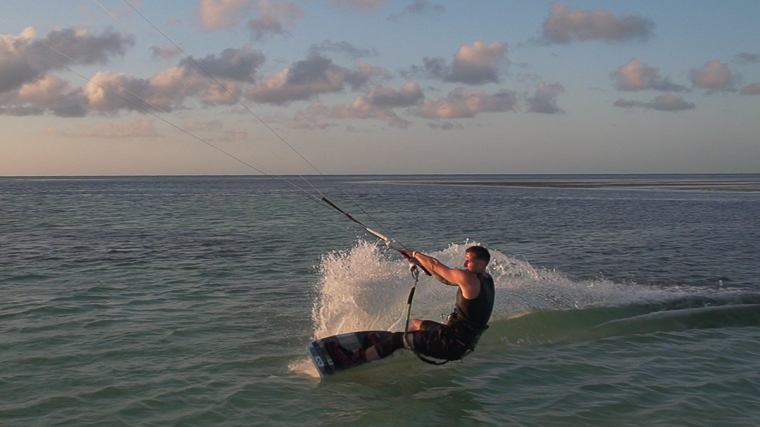
Don't bend at the hips
Drill three - Scooping for bigger pop
In this step, we'll talk about body posture and popping a half raley. We'll do a raley video as well. Remember, This is all about working your way up and developing muscle memory. I mentioned that unhooked riding is similar to cable wakeboarding in that you're using a progressive edge to build line tension. Let's take a look at the proper body posture for air tricks.
It's important to keep your hips locked on this trick. It's like you're sitting in a chair with good posture and leaning way back. If you bend like a hinge at your hips, you're going to kill all that energy you've built and choke out the pop. Likewise, if you let off your edge, you'll slip off the water.
The more tension you create, the harder you lean back, and the faster you go will impact how powerful your pop is. The release is equally important. With this step, you'll be working on loading more power into the lines so you will want to hold on with both hands.
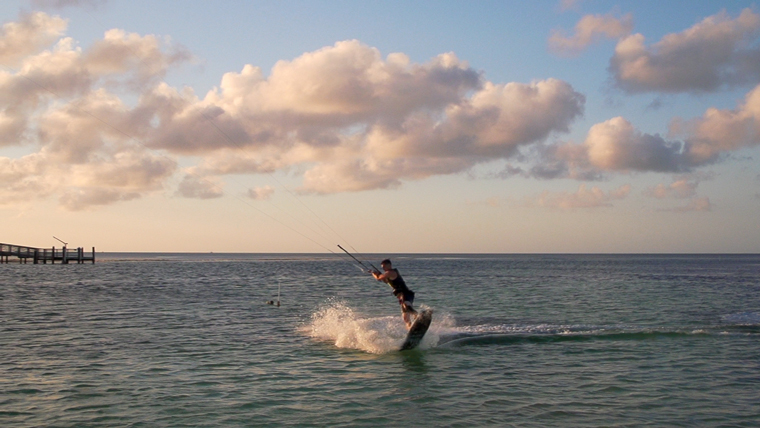
Imagine you're creating a ramp in the water
Let's talk about the scoop. Unlike the previous steps where you practiced an ollie, you're going to be edging away and scooping the board. Imagine digging your edge so hard that you create a ramp in the water. As you edge away, your board will be sitting deep in the water. Unlike the ollie, your nose will be facing away from the kite. As you dig your edge in and push off the back leg, the kite is going to pull you forward and your board is going to scoop away from the kite. As the board leaves the water, you want to point your toes and throw your legs back behind you. This is going to be similar to a raley, except your kite is high and you won't be very powered. Don't worry about getting your legs above your head or anything.
The landing is really important on this step. If you diligently practiced pulling the bar to your hip and landing downwind, it should be easy. As you feel yourself coming down, pull that bar hard into your lead hip, or even into your front knee. Point the nose of your board towards the kite. Land flat and downwind. You will feel the kite lose some power as you ride out the momentum of your board speed. Hook back in, lean back and ride upwind like normal.
The point of this drill is to build your understanding of how to load the kite, how to scoop the board, and how to control your landings. Be present for all of these steps. Think about your posture, feel the line tension. Be mindful of how your speed, edging, and release affect your pop.
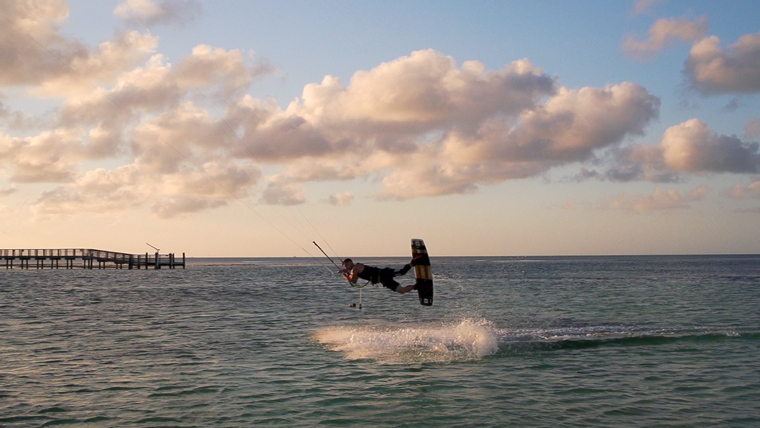
Do a small half raley
Bringing it all together
Now it's time to bring it all together. This is one of the most important steps in learning how to load a lot of power into the trick. The key here is to load your edge while you are still hooked in. With adequate power, come off your edge downwind to unhook. Keep your arms close, immediately carve back upwind, and scoop the board like you've been practicing.
Just like before, you can throw your legs gently behind you. Don't feel like you have to go for a full raley. We'll cover that in a later video. Keep working on getting more height and power out of your pop for the next couple sessions before moving forward.
The timing is the most important part of this trick. Up until now, you have been building your muscle memory and working on the basics. For more powered tricks, you want to get into the habit of building board speed and loading your lines while you are hooked in, as well as the timing of unhooking and quickly reloading and releasing. This will prevent you from burning out your arms while practicing and it will help you load more power into the kite.
Something I learned from Tucker here is, every time you learn a new trick, you should try it in the opposite direction. You'll double your bag of tricks and become a more well-rounded rider. If ever there was a time to try this, it would be on the pop as you can't learn new tricks without it!
Final tips:
- Keep the kite higher when learning this, but your goal should be to keep it progressively lower. Start at 11 or 1 o'clock.
- As you pop, get in the habit now of flicking your kite down a little after you pop it!
- Practice taking your back hand off for a better-looking landing.
 Ryan (Rygo) Goloversic
Ryan (Rygo) Goloversic
Just a dude from a kite shop testing all the gear one session at a time.
Many people dream of quitting their job, traveling the world and pursuing their passions. Rygo is one of those people who pulled the trigger. A few years into a postal career, he decided to change everything and travel as a kiteboarder, freelance videographer & writer. His mission is to help people and share the stoke. Get out there and kite!
Producer of: Ride with Blake I Sessions I Versus I Destinations I Foil Fridays
Recent Posts
-
North Navigator Pro Quick Release | How to Swap Yours Out With Ease
What You Need Before starting the replacement process, ensure you have all the necessary t …18th Apr 2024 -
Foil Drive | Essential Tips to Supercharge Your First Session
The Foil Drive makes your foiling life easier. You'll get up easier and catch more waves, …17th Apr 2024 -
2024 Duotone Slick Wing Review | What's New in This Year's Model?
The Duotone Slick has been a favorite of many for several years. Pros love it for its speed, …15th Apr 2024

